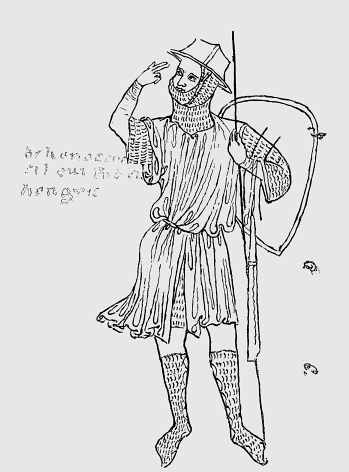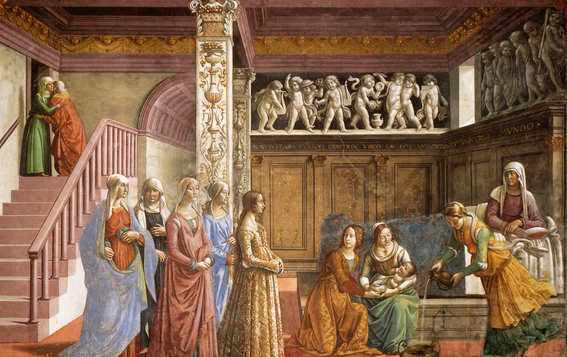Art pieces belonging to different time periods are significant to be restored and recovered because they provide the important information about the aspects of life, progress, and spirituality of the people living during different eras. From this point, it is necessary to focus on the art heritage related to the Medieval and Early Italian Renaissance periods. Referring to the Medieval period, it is possible to state that the most important, complex, and detailed information about the society of the Middle Ages can be gained from the Sketchbook by Villard De Honnecourt, the French architect and artist (Bowie 12). The fresco Birth of the Virgin by Domenico Ghirlandaio, the Italian painter, is also of the great cultural and historical significance because of demonstrating the elements of the style typical for the Early Italian Renaissance (Kuiper 148). Although the art pieces created by Villard De Honnecourt and Domenico Ghirlandaio belong to different time periods, present different artistic styles, and reflect different cultural contexts, these works should be chosen for the recovery and discussed in detail because Villard De Honnecourt’s Warrior from the Sketchbook is the unique representation of a standing warrior to form the knowledge about the Medieval life, and Domenico Ghirlandaio’s fresco is the perfect illustration of the art and spiritual life of Italy in the 15th century.
Villard De Honnecourt’s Warrior represented in the artist’s Sketchbook was drawn in about 1230. There is little biographical information known about the artist because the Sketchbook is the only source of information about the author (Bowie 12). While discussing the stylistic significance of the Warrior, it is important to note that the sketch is drawn in ink on parchment. The figure of the warrior is depicted rather realistically, and the lines are clear. Much attention is paid to describing the man’s garments. The warrior wears the chain armor and helmet (Ross 60). The style of the drawing can be discussed as rather simple, and it differs from the traditional Medieval paintings significantly (Picture 1). That is why, much attention should be paid to this example of the unique Medieval drawing.

The symbolic message of the drawing is rather unknown because the researchers do not know the purpose of Villard’s drawings presented in the Sketchbook. However, the cultural and historical significance of the discussed drawing and the whole Sketchbook is great because the author illustrates the social life of the French people during the Medieval period while focusing on their garments, activities, architecture, and used devices. The Warrior provides the important information about the activities of the knights respected during the Medieval period, demonstrates the important elements of the outfit and used devices. While discussing the cultural significance of the sketches, Ross notes that “there is really nothing else exactly like Villard’s sketchbook to survive from any time during the medieval period and so this work has puzzled scholars for many years” (Ross 61). Thus, Villard’s work should be referred to as the significant art piece because of providing a lot of unique historical information for the viewers.
Domenico Ghirlandaio’s Birth of the Virgin is the distinctive example of the Early Italian Renaissance art. The famous Italian painter worked at the fresco during the period of 1486-1490. The fresco represents the scene of Mary’s birth. The space of the fresco is perfectly constructed and divided among the presenting figures. The movements and poses of depicted women are graceful and attractive. The fresco is rather vivid, and warm colors are dominant. In this fresco, Ghirlandaio uses his preferable technique of the parallel hatching (Lee Rubin 240). The style of Ghirlandaio is rather distinctive because the artist intends to combine the religious message and the contemporary Florentine decorative art. The figures of angels in the fresco are presented along with the figures of women who look like secular figures (Picture 2). The combination of different colors, approaches, and themes in one piece of art is the characteristic feature of Ghirlandaio’s style which contributes to the overall uniqueness of his work.

The cultural and historical significance of Ghirlandaio’s Birth of the Virgin is in the fact that the painter attempted to present religious subjects and messages with the help of contemporary tools. The discussed fresco is painted according to the principles and techniques used by the artists of the Early Italian Renaissance because during that period, artists tried to recover religious ideas in rather secular forms. Ghirlandaio’s Birth of the Virgin is significant to be analyzed in detail because this masterpiece demonstrates how Ghirlandaio portrayed patrons and other women known in Florence of the 15th century while revealing the important religious idea of the Virgin’s birth. Thus, Ludovica Tornabuoni, the patron, is represented in the fresco in order to link the biblical ideals and the reality of contemporary Florence. In this fresco, Ghirlandaio illustrates how the secular life of Florence during the period of the Early Italian Renaissance is closely connected with the religious life (Kuiper 148). The combination of these two forces affecting the life of Italy during the period is vividly depicted in the fresco. That is why, the art piece can be considered as the remarkable source to explain the aspects of life in Florence of the 15th century.
The sketch by Villard De Honnecourt known as Warrior and drawn in the 13th century should be discussed as the culturally and historically significant art piece because it provides researchers and viewers with a lot of questions and answers about the life and art of the Medieval period. On the one hand, the sketch is detailed and rather representative. It provides the answers to the questions about the daily life of the Medieval people. On the other hand, the purpose of the drawing is still unknown, and this sketch seems to be a unique example taken from the Medieval portfolio by Villard De Honnecourt. That is why, researchers still try to find the answers to questions about the artist’s biography. The fresco Birth of the Virgin painted by Domenico Ghirlandaio is also exceptional because it allows researchers to understand the quality and role of the social links in Florence of the 15th century as it is reflected in the Early Italian Renaissance art. In spite of the fact that the selected works are different in relation to their style, message, idea, and origin, the sketch and the fresco can be discussed as the remarkable illustrations related to the periods of the Medieval Era and Early Italian Renaissance.
Works Cited
Bowie, Theodore. The Medieval Sketchbook of Villard de Honnecourt. New York, NY: Courier Dover Publications, 2012. Print.
Kuiper, Kathleen. The 100 Most Influential Painters and Sculptors of the Renaissance. New York, NY: The Rosen Publishing Group, 2009. Print.
Lee Rubin, Patricia. Images and Identity in Fifteenth-Century Florence. New Haven, CT: Yale University Press, 2007. Print.
Ross, Leslie. Artists of the Middle Ages. New York, NY: Greenwood Publishing Group, 2003. Print.